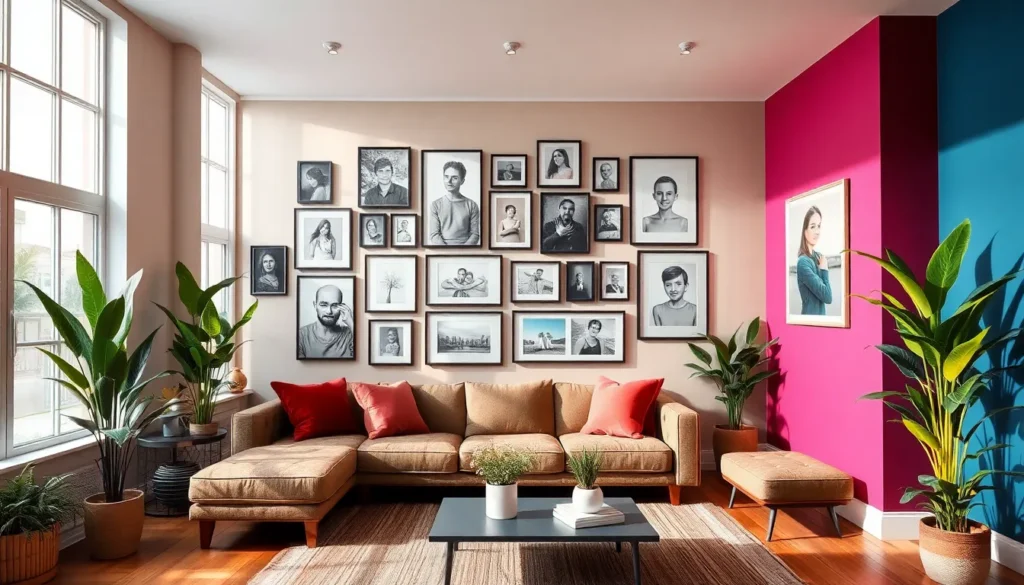We’ve all stared at that blank living room wall wondering how to transform it from boring to breathtaking. Your walls are prime real estate for showcasing personality and creating visual impact that guests will remember long after they leave.
The right wall decor can completely revolutionize your space – turning a sterile room into a warm gathering place or making a small area feel dramatically larger. Whether you’re working with a tiny apartment or a spacious family room we know you want maximum style impact without very costly.
From gallery walls that tell your story to statement pieces that command attention we’ll show you proven techniques that interior designers use to create stunning focal points. These aren’t just decorating tips – they’re strategic design moves that’ll make your living room the envy of every visitor.
Create a Stunning Gallery Wall With Mixed Artwork and Photography
Gallery walls transform bland living room walls into captivating focal points that reflect your unique style. We’ll guide you through creating a balanced display that combines artwork and photography for maximum visual impact.
Choose a Cohesive Color Palette
Select two to three main colors that appear throughout your living room’s existing decor. This approach creates visual harmony between your gallery wall and furniture pieces like sofas, throw pillows, or area rugs.
Neutral tones work exceptionally well for gallery walls because they complement various artwork styles. Colors like cream, gray, navy, or sage green provide a sophisticated backdrop that won’t compete with your displayed pieces.
Consider your room’s lighting when choosing your palette. Warm lighting enhances earthy tones like terracotta and golden yellows, while cool lighting makes blues and grays appear more vibrant.
Repeat your chosen colors across different pieces in your gallery arrangement. This might mean selecting photographs with similar color tones or choosing artwork that features your palette’s key hues.
Mix Different Frame Sizes and Styles
Start with larger pieces measuring 16×20 inches or 18×24 inches as your anchor points. These substantial frames create visual weight and help establish the gallery wall’s overall structure.
Add medium-sized frames between 8×10 and 11×14 inches to fill gaps and create visual flow. These transitional pieces connect your statement pieces with smaller accent frames.
Include small frames ranging from 4×6 to 8×10 inches for intimate details and personal touches. These petite pieces add visual interest without overwhelming the display.
Vary your frame materials and finishes to create texture and depth. Combine wooden frames with metal options, or mix matte black frames with brass or gold accents for sophisticated contrast.
Maintain consistent spacing of 2 to 3 inches between frames regardless of their size differences. This uniform gap creates a polished, professional appearance that interior designers frequently use.
Include Personal Photos and Prints
Display family photos alongside professional artwork to create an emotional connection to your space. Black and white family portraits work particularly well because they complement any color scheme.
Add travel photography from your personal adventures to spark conversation and showcase your experiences. These images become natural talking points when entertaining guests.
Include children’s artwork in coordinating frames to celebrate creativity while maintaining the gallery’s sophisticated appearance. This personal touch makes your living room feel uniquely yours.
Mix professional prints with personal photography to create layers of meaning and visual interest. Art prints from local artists or online marketplaces can complement your personal images beautifully.
Consider the subject matter balance across your entire gallery wall. Aim for a mix of landscapes, portraits, abstract pieces, and personal moments to create a well-rounded visual story.
Transform Your Space With Bold Statement Wall Paint or Wallpaper

Moving beyond gallery walls, we can completely transform our living room’s atmosphere using bold paint colors or striking wallpaper patterns. Deep indigo, charred terracotta, sunny yellow, and acidic green create powerful focal points that instantly showcase our personality and design vision.
Select an Accent Wall for Maximum Impact
Choosing one wall to paint or decorate differently from the others creates a stunning visual focal point that draws attention without overwhelming the space. We recommend selecting a color that contrasts with or goes deeper than our existing palette to add character and depth to the room.
Deeper hues work exceptionally well when we pair them with lighter surrounding walls, while bright colors can energize spaces dominated by neutral tones. Popular 2025 paint colors range from versatile neutrals like white, off-white, and greige to rich deeper tones like burgundy and brown that provide sophisticated backdrops.
Materials beyond paint offer exciting texture possibilities for our accent walls. Wood panels create warmth and rustic charm, while stone surfaces add natural elegance. Patterned wallpaper brings intricate designs that serve as artistic statements in themselves.
Strategic accent wall placement sets the entire room’s tone, creating either cozy intimate atmospheres or energetic vibrant spaces depending on our color choices. We can enhance architectural interest further by painting trim and molding in matching or complementary bold shades.
Consider Textured Paint Techniques
Textured paint techniques add physical depth and visual interest that goes far beyond what flat color alone can achieve. These methods create tactile dimensions that make our walls captivating to both sight and touch.
Sponge painting creates organic, cloud-like patterns that soften harsh lines and add subtle movement to our surfaces. We can layer multiple colors for complex, sophisticated effects that change appearance throughout the day as lighting shifts.
Rag rolling produces elegant, fabric-like textures that mimic expensive wallcoverings at a fraction of the cost. This technique works particularly well in traditional or transitional living rooms where we want refined sophistication.
Plaster finishes offer bold, dramatic textures that range from subtle Mediterranean influences to striking contemporary statements. We can highlight existing architectural features like alcoves or built-ins using these techniques to create stunning focal points.
Explore Removable Wallpaper Options
Removable wallpaper provides flexible, non-permanent answers that let us introduce bold patterns or textures without long-term commitment. This option works perfectly for renters or anyone who enjoys frequently updating their decor.
Application and removal processes are surprisingly simple, requiring no special tools or professional installation. We can transform our walls in hours rather than days, and removal won’t damage the underlying surface when we’re ready for changes.
Style variety ranges from geometric patterns to delicate florals, offering options that complement any design aesthetic. Many removable wallpapers mimic expensive materials like wood grain, stone, or luxury fabrics at affordable prices.
Texture mimicry capabilities allow us to achieve high-end looks without renovation costs or permanence concerns. We can experiment with grasscloth textures, brick patterns, or metallic finishes to find what works best in our exact lighting and furniture arrangement.
Add Dimension With Floating Shelves and Display Ledges
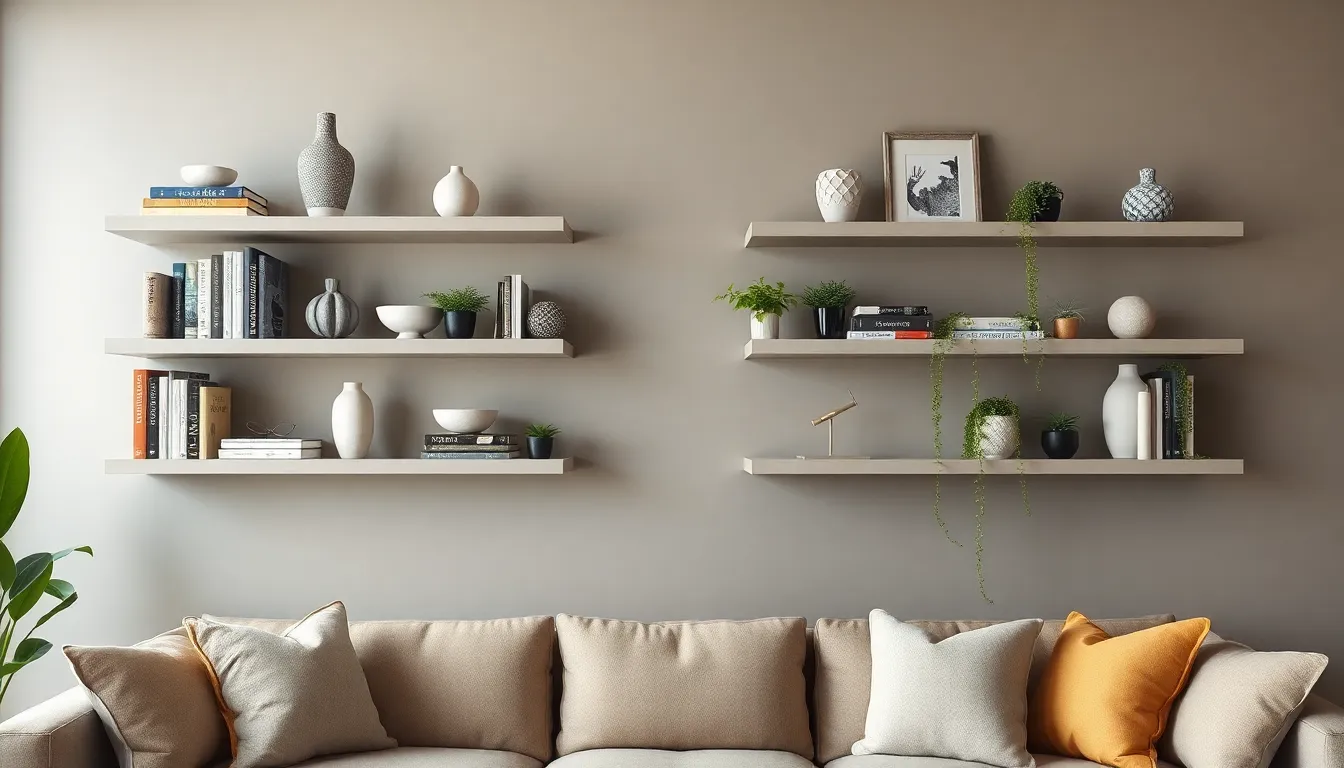
Floating shelves create an elegant foundation for layered wall displays that don’t require permanent installation. We can achieve a sleek, modern look while maintaining flexibility to change our decor seasonally.
Style Shelves With Books and Decorative Objects
Books become powerful design elements when we arrange them both vertically and horizontally on floating shelves. Mixing hardcover novels with art books creates visual weight while decorative objects like ceramic vases, sculptural pieces, and framed photos fill the gaps between book groupings.
Varying the heights of our displayed items prevents the shelf from looking flat or monotonous. We recommend placing taller objects like candlesticks or small sculptures at different points along the shelf rather than clustering them together.
Color coordination transforms random collections into cohesive displays. Grouping books by spine color or selecting decorative objects that echo our room’s existing palette creates harmony throughout the space.
Create Symmetrical or Asymmetrical Arrangements
Symmetrical arrangements work beautifully when we want to create balance around a central focal point like a fireplace or large artwork. Placing identical objects or matching sets of books on either side of this central element establishes visual equilibrium that feels calm and organized.
Asymmetrical displays offer more ever-changing energy by mixing different sizes and shapes across our shelving system. We can achieve this by placing a large decorative bowl on one end while balancing it with several smaller items grouped on the opposite side.
The rule of thirds guides our asymmetrical arrangements effectively. Dividing each shelf into three sections and placing our most eye catching pieces at these division points creates natural visual stopping points that draw attention.
Incorporate Greenery and Small Plants
Plants breathe life into our floating shelf displays while adding natural texture that softens harder decorative elements. Small potted succulents, trailing pothos, or compact snake plants thrive in the indirect light that most living room shelves receive.
Hanging planters work exceptionally well when suspended from shelves at varying heights. This technique creates vertical gardens that draw the eye upward and make our ceilings appear taller.
Mixing live plants with high quality artificial greenery ensures our displays stay fresh looking year round. We can rotate seasonal plants while maintaining consistent green elements that don’t require ongoing care or exact lighting conditions.
Install Eye-Catching Wall Mirrors to Expand Your Living Room
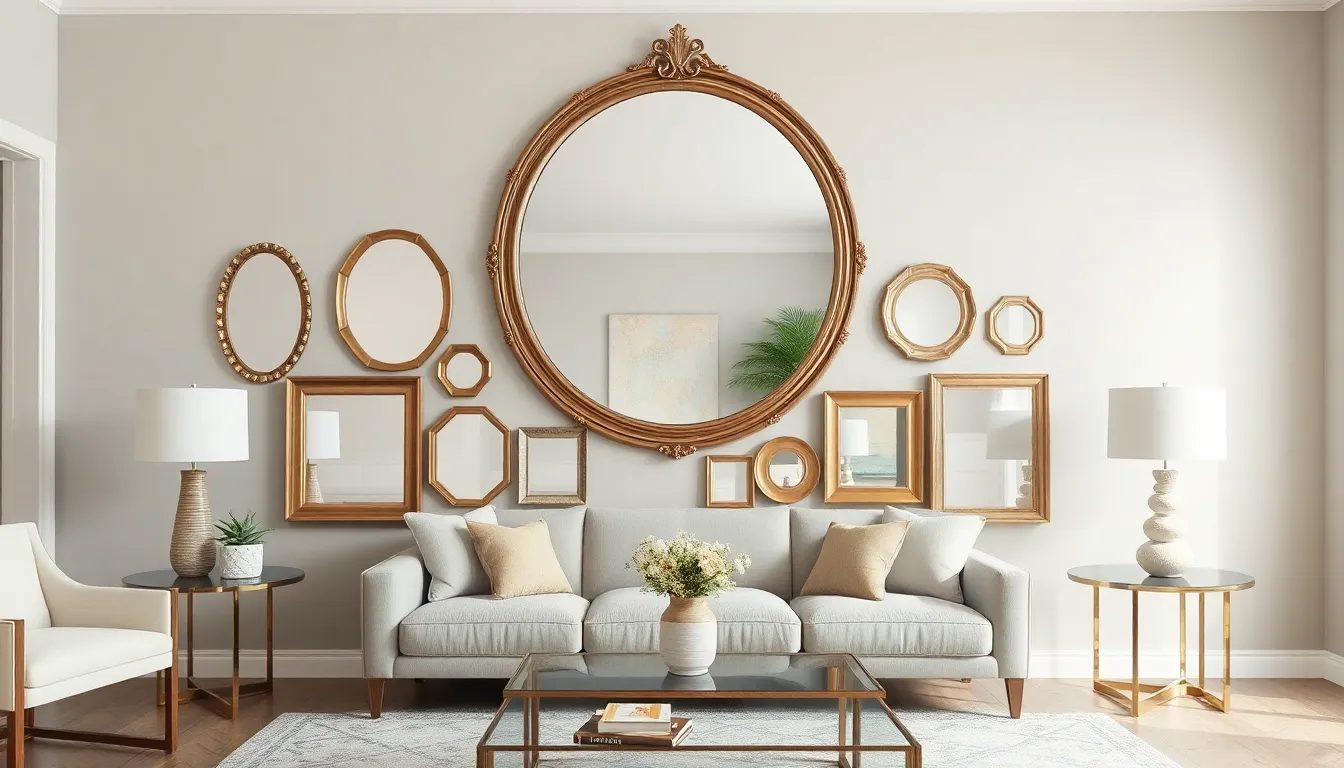
Mirrors create the illusion of a larger space by reflecting light and images throughout your living room. We’ll show you how strategic mirror placement can transform your walls into powerful design elements that brighten and visually expand your space.
Use Large Statement Mirrors as Focal Points
Position a statement mirror like the Gleaming Primrose mirror from Anthropologie above your sofa to create an instant focal point. Large mirrors serve as architectural elements that draw the eye upward while reflecting natural light from windows across the room. We recommend selecting mirrors that measure at least 36 inches in width to achieve maximum visual impact on standard living room walls.
Statement mirrors work best when they’re proportional to your furniture beneath them. Hang your mirror so its center sits 6 to 8 inches above your sofa back for optimal visual balance. Consider mirrors with unique shapes like sunburst designs or geometric forms to add personality while maintaining the space expanding benefits.
Arrange Multiple Small Mirrors in Clusters
Grouping small mirrors together creates visual interest and adds sparkle to your walls without overwhelming the space. We suggest starting with three to five mirrors in varying sizes, arranging them in an asymmetrical cluster for ever-changing appeal. Mix circular and rectangular shapes to create movement and prevent the arrangement from looking too uniform.
Space your clustered mirrors 2 to 4 inches apart to maintain cohesion while allowing each piece to shine individually. Begin with your largest mirror as an anchor point, then arrange smaller pieces around it in a way that feels balanced but not perfectly symmetrical. This technique works particularly well on walls adjacent to windows where the mirrors can catch and multiply natural light.
Choose Mirrors With Decorative Frames
Select mirrors with intricate or bold frames to add an extra layer of decor to your walls beyond their reflective function. Ornate gold frames complement traditional and glamorous decor styles, while sleek black or silver frames suit modern and minimalist spaces. We find that textured frames in materials like rattan, wood, or metal add depth and visual interest to your wall composition.
Frame thickness matters when creating impact with decorative mirrors. Choose frames that are at least 2 to 3 inches wide to ensure they read as intentional design elements rather than basic functional pieces. Consider how your mirror frames coordinate with other metal finishes in your room, such as light fixtures, hardware, and furniture accents for a cohesive look.
Incorporate Natural Elements With Wood Wall Treatments
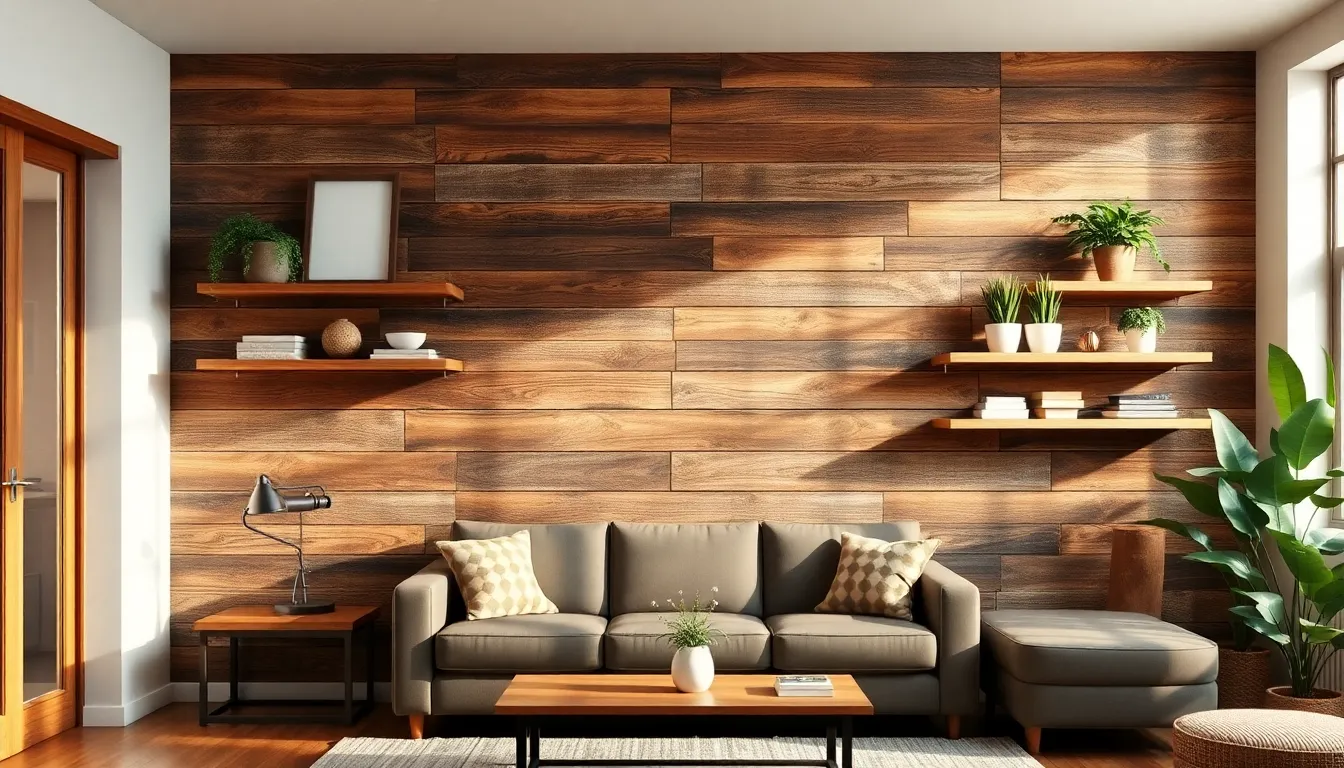
Natural wood elements bring immediate warmth and organic texture to living room walls. These treatments create cozy atmospheres while adding visual depth that complements both modern and traditional decor styles.
Install Shiplap or Wood Paneling
Shiplap installation transforms plain walls into stunning focal points with rustic or vintage character. The horizontal lines create visual width and add architectural interest that makes rooms feel more spacious and inviting.
Wood paneling offers versatility in design choices, from classic beadboard to contemporary vertical slats. We recommend measuring wall dimensions carefully before installation to ensure proper spacing and alignment for professional results.
Different wood species provide unique grain patterns and color variations that enhance your living room’s personality. Cedar brings natural aromatics, while pine offers budget friendly options that paint beautifully for customized looks.
Installation typically requires basic carpentry skills and standard tools like a level, nail gun, and measuring tape. Professional installation ensures proper wall preparation and seamless finishing that maximizes the visual impact of your wood treatments.
Create a Rustic Accent Wall With Reclaimed Wood
Reclaimed wood accent walls introduce history and sustainable materials into living room designs. Each board tells a story through weathered textures, nail holes, and natural patina that creates authentic character impossible to replicate with new materials.
Barnwood and salvaged lumber provide the most dramatic rustic effects with their weathered surfaces and varied colorations. We suggest selecting boards with consistent thickness while embracing natural imperfections that add to the authentic charm.
Proper preparation includes cleaning reclaimed wood thoroughly and checking for loose nails or splinters before installation. Sealing the wood preserves its natural beauty while protecting against moisture and everyday wear that could damage the surface over time.
Strategic lighting enhances the texture and depth of reclaimed wood walls, creating shadows that emphasize the natural grain patterns. Accent lighting positioned at angles highlights the three dimensional qualities that make these walls such compelling focal points.
Add Floating Wood Shelves for Warmth
Floating wood shelves combine functional storage with natural warmth that enhances living room walls. These installations create elegant displays while maintaining clean lines that complement modern decor schemes without overwhelming smaller spaces.
Natural wood grain adds organic texture that softens hard wall surfaces and creates visual balance with other room elements. We recommend choosing shelf wood that coordinates with existing furniture finishes for cohesive design that flows throughout the space.
Strategic placement at varying heights creates ever-changing visual interest while providing practical display space for books, plants, and decorative objects. The floating design keeps walls looking clean and uncluttered while maximizing storage potential in compact living areas.
Installation requires proper wall anchoring to support the weight of displayed items safely. Hidden brackets maintain the floating appearance while providing sturdy support that prevents sagging or wall damage over time.
Display Textile Wall Hangings and Tapestries for Texture
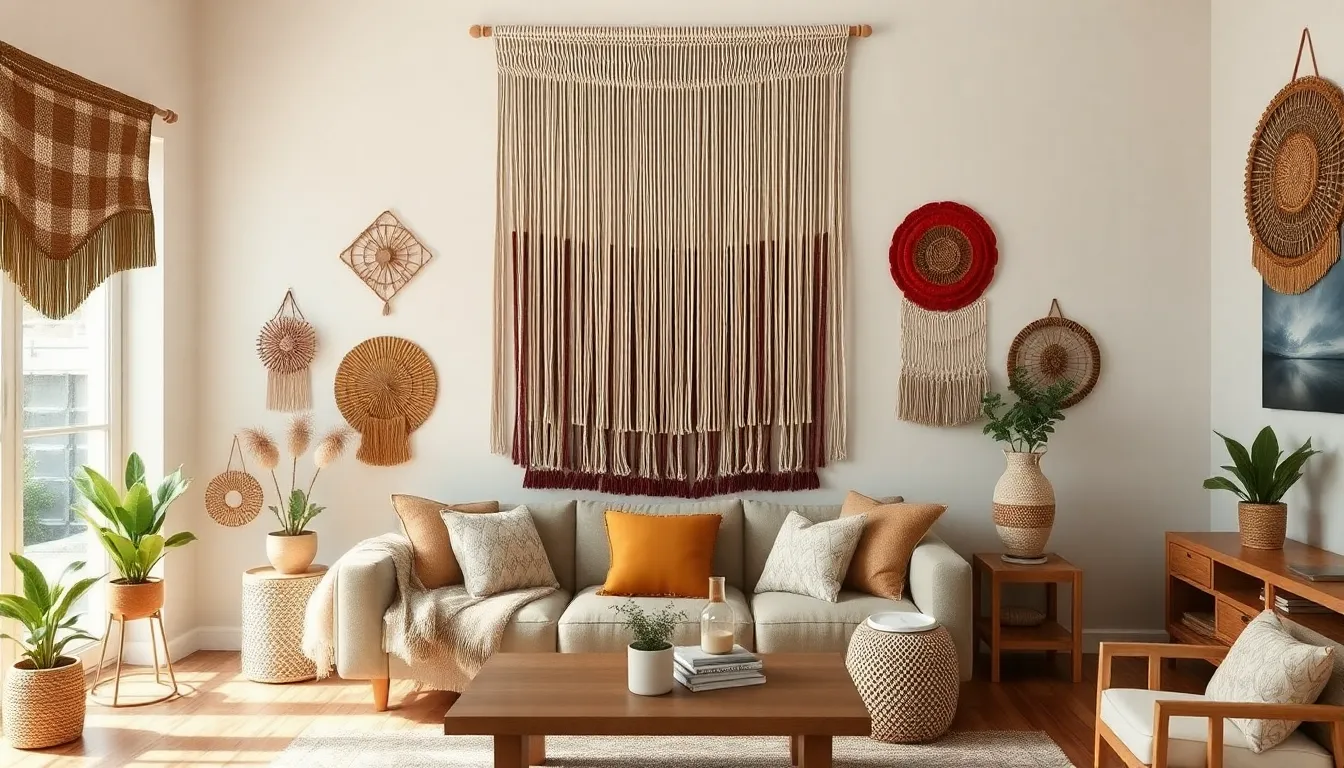
Textile wall decor transforms flat surfaces into ever-changing focal points that add warmth and visual interest to our living spaces. Woven tapestries and intricate macramé pieces create depth while introducing organic textures that complement both modern and traditional design schemes.
Choose Macrame Wall Hangings for Bohemian Style
Macrame wall hangings serve as perfect statement pieces for creating an authentic bohemian atmosphere in our living rooms. These intricate handwoven designs feature natural fibers like cotton cord, jute, and hemp that add organic texture to plain walls. We can select large-scale macrame pieces measuring 3-4 feet wide to anchor seating areas, or arrange smaller 12-18 inch hangings in clusters for visual impact.
Neutral tones work exceptionally well for macrame decor, with cream, beige, and natural white colors complementing most existing color palettes. Geometric patterns and flowing fringe details create movement and softness that balances harder furniture lines. Positioning macrame hangings above sofas or behind accent chairs establishes clear focal points while maintaining the relaxed, artistic vibe characteristic of bohemian design.
Hang Large Tapestries as Statement Pieces
Large tapestries function as dramatic focal points that instantly transform our living room walls into artistic showcases. These oversized textile pieces typically measure 5-8 feet in width, creating bold visual anchors that draw the eye and establish room themes. We can choose from traditional woven designs, contemporary abstract patterns, or nature-inspired motifs depending on our existing decor style.
Strategic placement above main seating areas maximizes visual impact while creating cozy conversation zones beneath. Tapestries with rich colors and intricate details work particularly well in minimalist spaces where they provide necessary visual weight and character. Mounting systems using wooden dowels or decorative rods allow for easy seasonal changes while maintaining professional installation quality.
Layer Different Textile Textures
Combining multiple textile textures creates sophisticated depth that elevates our wall decor beyond single-piece displays. We achieve this layered approach by mixing smooth linen pieces with nubby wool hangings, or pairing sleek cotton tapestries with rough jute macrame. Different weaving techniques produce varying surface textures that catch light differently throughout the day.
Overlapping smaller textile pieces at different heights adds visual complexity without overwhelming the space. Natural fiber combinations like bamboo, hemp, and organic cotton create cohesive earth-tone palettes that complement wood furniture and stone accents. Scale variation proves essential, with larger background pieces supporting smaller detailed hangings that invite closer inspection and create intimate viewing experiences.
Mount Functional Wall Storage That Doubles as Decor
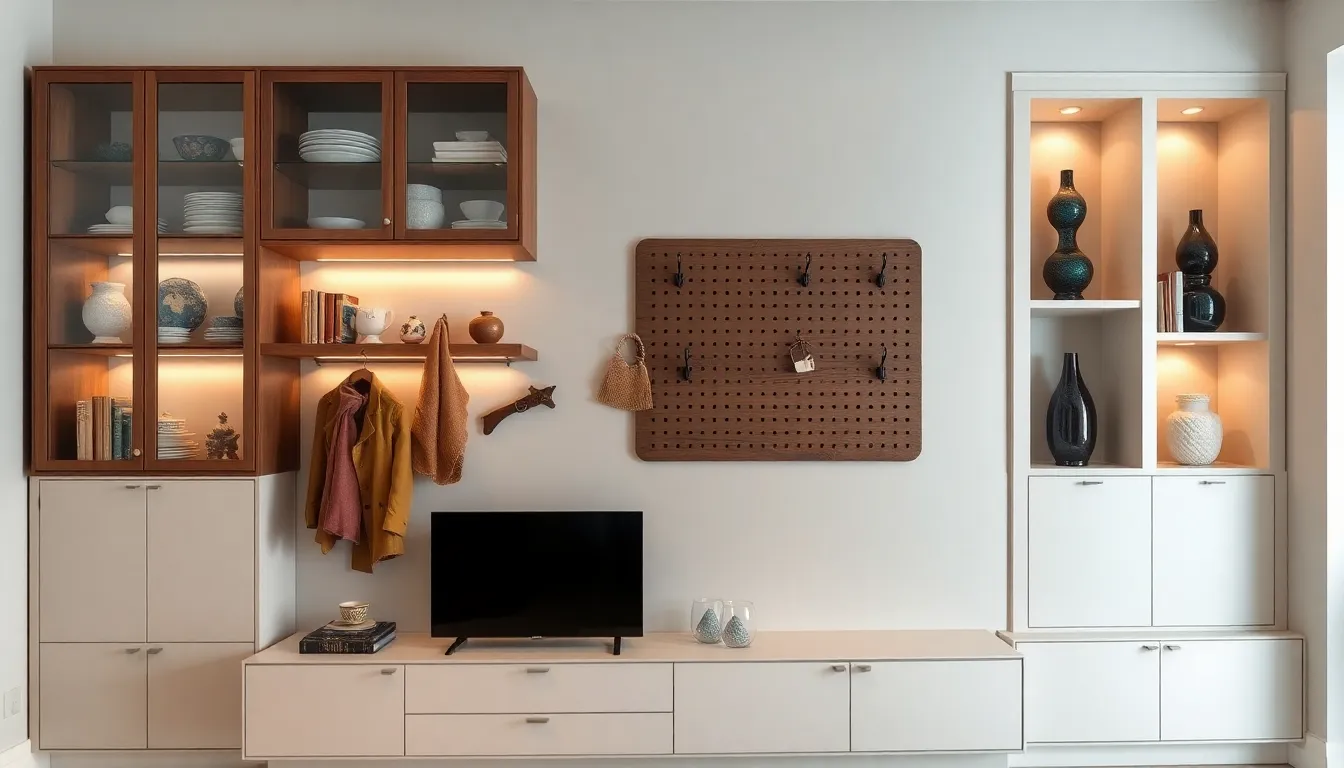
Smart wall storage answers transform empty walls into organized, beautiful focal points. These practical design elements eliminate clutter while creating stunning visual displays that enhance your living room’s overall aesthetic.
Install Stylish Wall-Mounted Cabinets
Wall-mounted cabinets offer elegant storage answers that serve both aesthetic and practical purposes in modern living spaces. These sophisticated units can house books, decorative items, or even kitchenware in open-plan areas while adding a touch of elegance to your room’s design.
Floating cabinet designs create clean lines that make walls appear taller and rooms feel more spacious. Choose cabinets with glass fronts to display cherished collections like vintage books or decorative ceramics. Wood finishes complement natural wall treatments we’ve discussed, while sleek metal options pair beautifully with contemporary mirror arrangements.
Strategic placement above seating areas maximizes both storage capacity and visual impact. Position cabinets at eye level for easy access to frequently used items. Multiple units arranged in geometric patterns create compelling wall compositions that rival traditional gallery walls.
Use Decorative Hooks and Pegboards
Decorative hooks and pegboards transform functional storage into striking wall art installations. These versatile systems keep coats, bags, and accessories organized while maintaining visual appeal through thoughtful design choices.
Modern pegboard systems come in various materials including wood, metal, and acrylic that coordinate with your existing decor palette. Brass hooks add warm metallic accents that complement textile wall hangings, while matte black options provide bold contrast against light colored walls.
Arrange hooks in interesting patterns rather than straight lines to create ever-changing visual interest. Group different hook styles and sizes together for an eclectic look that feels intentional rather than random. Position pegboards near entryways or behind furniture to maximize their practical benefits while maintaining room flow.
Add Built-In Wall Niches for Display
Built-in wall niches provide dedicated spaces to showcase decorative items such as sculptures, vases, or small art pieces. These architectural elements create depth and dimension while offering permanent display answers that integrate seamlessly with your wall design.
Recessed niches work particularly well in accent walls with textured materials like wood panels or stone surfaces. LED strip lighting inside each niche highlights displayed objects and creates dramatic shadow effects that enhance the overall ambiance.
Size niches proportionally to accommodate your treasured items while maintaining visual balance with surrounding elements. Large niches house statement pieces like pottery or books, while smaller openings perfectly frame individual objects. Paint niche interiors in contrasting colors to make displayed items pop against the background.
Multiple niches arranged asymmetrically follow design principles similar to floating shelf arrangements, creating sophisticated displays that evolve with your decorating needs.
Create Visual Interest With 3D Wall Art and Sculptures

Three-dimensional wall art transforms flat surfaces into ever-changing focal points that command attention and add depth to your living space. Moving beyond traditional two-dimensional pieces creates tactile appeal and visual intrigue that instantly elevates your room’s sophistication.
Mount Metal Wall Sculptures
Metal sculptures bring a modern, industrial edge to living rooms while reflecting light throughout your space. These versatile pieces work beautifully in both minimalist and maximalist design schemes, offering customizable size and style options to fit your exact aesthetic.
Strategic placement above your sofa or along accent walls creates striking focal points that draw the eye upward. Large geometric metal pieces serve as conversation starters, while smaller clustered sculptures create rhythm and movement across your wall surface. The reflective properties of metal add brightness to darker corners and enhance your room’s overall lighting scheme.
We recommend selecting pieces that complement your existing color palette through bronze, copper, or brushed steel finishes. Consider the scale of your room when choosing sizes, ensuring larger pieces have adequate breathing room while smaller collections maintain proper spacing for maximum visual impact.
Install Ceramic or Wooden Wall Art
Natural materials like wood and ceramic bring organic warmth and texture to your living room walls. Wooden wall art complements styles ranging from rustic farmhouse to sleek contemporary, offering versatility that adapts to changing decor trends.
Ceramic pieces provide unique shapes and glazes that create stunning visual contrast against painted walls. These handcrafted elements introduce artisanal character while maintaining sophisticated appeal. Layer different ceramic textures and finishes to build depth and create curated gallery style arrangements.
Wooden sculptures and relief panels add dimensional interest through natural grain patterns and carved details. Position these pieces where natural light can highlight their texture and create subtle shadow play throughout the day. Group multiple wooden elements of varying sizes to establish visual rhythm while maintaining cohesive material consistency.
Add Paper or Fabric Wall Installations
Paper-based and fabric wall art introduces softness and intricate patterns without overwhelming your living space. Origami-inspired installations create delicate geometric forms that cast interesting shadows while adding contemporary artistic flair.
Woven tapestries and fabric pieces bring color and creative detail through their textile qualities. These installations work particularly well in creating cozy conversation areas where their tactile nature invites closer inspection. Layer different fabric textures to build sophisticated depth while maintaining visual coherence.
Paper sculptures offer endless customization possibilities through color combinations and folding techniques that match your exact design vision. Position these delicate installations away from high-traffic areas to preserve their intricate details while ensuring they remain prominent decorative features.
Enhance Ambiance With Strategic Wall Lighting Solutions
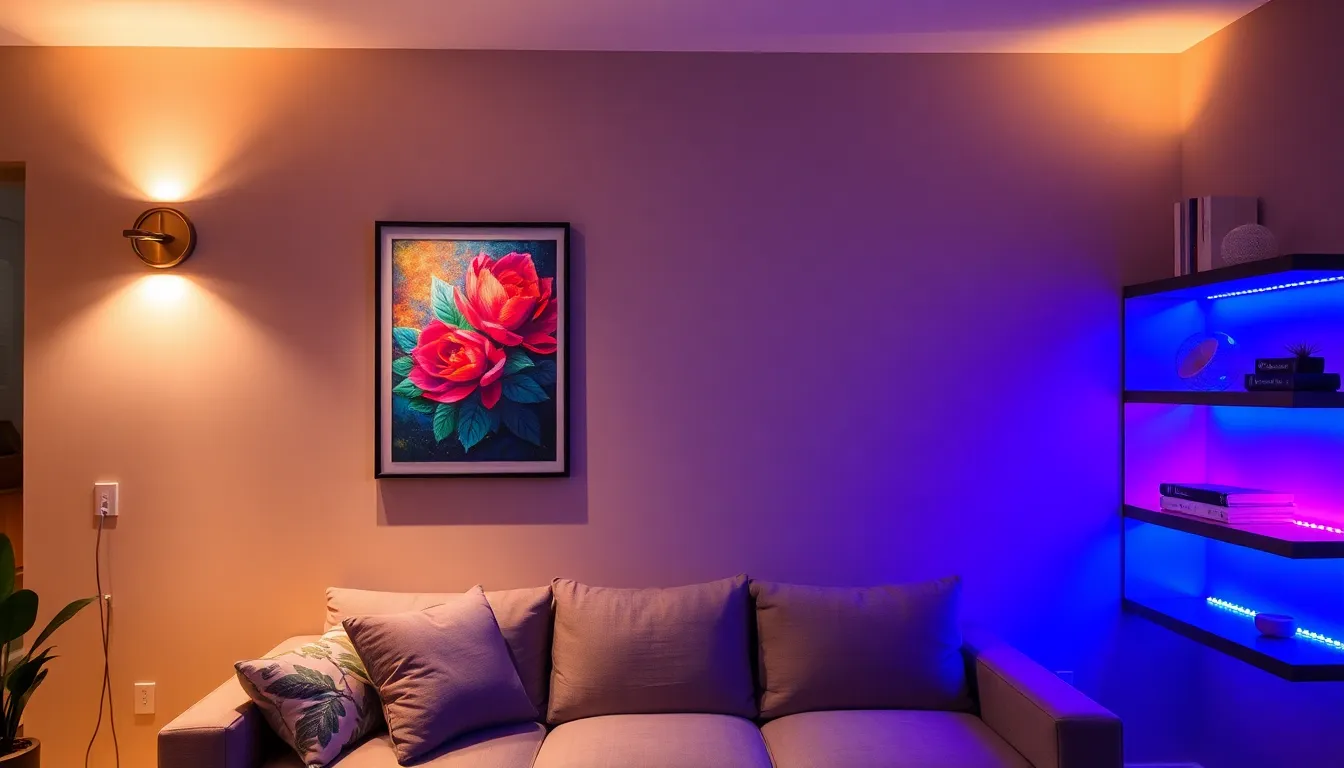
Strategic lighting transforms wall decor from ordinary displays into captivating focal points that elevate your entire living space.
Install Picture Lights for Artwork
Picture lights create dramatic illumination that transforms your artwork into stunning wall features. We recommend installing adjustable picture lights directly above each piece to eliminate shadows and highlight the colors and textures of your favorite paintings or photographs. LED picture lights offer energy efficiency while providing consistent, warm lighting that won’t damage delicate artwork over time.
Position picture lights approximately 30 degrees from the wall surface to achieve optimal illumination without creating glare or hotspots. Hardwired picture lights provide the cleanest look and eliminate visible cords, while battery operated options offer flexibility for renters or temporary displays. Choose brass or bronze finishes to complement traditional decor, or select sleek black and chrome options for modern living spaces.
Add Wall Sconces for Ambient Lighting
Wall sconces provide soft, ambient lighting that creates a warm and inviting atmosphere throughout your living room. We suggest installing sconces at eye level, typically 60 to 66 inches from the floor, to ensure comfortable lighting for reading and conversation. Uplight sconces bounce light off the ceiling to create gentle, diffused illumination, while downlight options provide focused task lighting for exact areas.
Dimmer switches allow you to adjust sconce brightness throughout the day, creating different moods from bright morning light to cozy evening ambiance. Swing arm sconces offer flexibility for reading areas, while fixed sconces work perfectly as accent lighting beside artwork or architectural features. Choose sconces with fabric shades for softer light distribution or metal shades for more directed illumination.
Use LED Strip Lights Behind Wall Features
LED strip lights create stunning backlighting effects that add depth and visual interest to floating shelves, wall mounted artwork, and architectural details. We recommend installing color changing LED strips to customize your lighting based on seasons, occasions, or personal preferences. Cool white LEDs enhance modern decor schemes, while warm white strips complement traditional and rustic design elements.
Hide LED strips behind crown molding, picture ledges, or floating shelves to create a subtle glow that highlights your wall displays without visible light sources. Smart LED strips connect to home automation systems, allowing you to control brightness and color through smartphone apps or voice commands. Waterproof LED strips work well in areas with higher humidity, while standard strips provide excellent performance in typical living room conditions.
Conclusion
We’ve explored countless ways to transform your living room walls from blank canvases into stunning focal points that reflect your unique style. Whether you choose gallery walls mixed media displays bold accent colors or natural wood treatments each approach offers its own benefits for creating visual impact.
The key to successful wall decor lies in balancing functionality with aesthetics. Floating shelves provide storage while showcasing your favorite items and strategic lighting enhances every element you’ve carefully chosen. Textile hangings add warmth while three-dimensional art creates depth that draws the eye.
Remember that the best wall decor speaks to your personality and lifestyle. Start with one technique that resonates with you then gradually layer additional elements as your confidence grows. Your living room walls are waiting to tell your story – now you have the tools to make them truly shine.
Frequently Asked Questions
What is the most cost-effective way to decorate a blank living room wall?
Creating a gallery wall is one of the most budget-friendly options. Mix personal photos with affordable prints, use frames from thrift stores, and arrange them strategically. Start with a cohesive color palette and vary frame sizes for visual interest. This approach transforms your space without expensive artwork or major renovations.
How do I choose the right accent wall color for my living room?
Select a color that either contrasts with or deepens your existing palette. Consider your room’s lighting conditions and test paint samples at different times of day. Popular 2025 colors include warm earth tones and bold jewel tones. The accent wall should complement, not clash with, your current decor scheme.
What’s the best way to arrange artwork in a gallery wall?
Start with larger anchor pieces as focal points, then fill in with medium and small frames. Maintain consistent spacing between pieces (typically 2-3 inches). Use painter’s tape to plan your layout on the floor first. Mix different frame styles while keeping a cohesive color scheme for a polished, professional look.
Can I use removable wallpaper in a rental apartment?
Yes, removable wallpaper is perfect for renters. It applies easily without adhesive damage and removes cleanly when you move. Choose bold patterns or textures to create instant focal points. Test a small corner first to ensure compatibility with your wall surface and always follow manufacturer instructions for best results.
How do I style floating shelves to look professional?
Mix books (both vertical and horizontal), decorative objects, and small plants. Vary heights of displayed items and follow the rule of thirds for placement. Coordinate colors with your room’s palette and leave some negative space to avoid clutter. Group items in odd numbers for more natural, visually appealing arrangements.
What size mirror should I use above my sofa?
Choose a large statement mirror that’s approximately two-thirds the width of your sofa. Hang it 6-8 inches above the sofa back for proper proportion. The mirror should be substantial enough to serve as a focal point while reflecting light to make your room appear larger and brighter.
Are wood wall treatments difficult to install?
Basic shiplap and wood paneling are DIY-friendly with proper tools and measurements. Start with accurate wall measurements and use a level for straight installation. For reclaimed wood accent walls, ensure proper preparation and sealing. Consider hiring professionals for complex installations or if you’re uncomfortable with power tools and construction techniques.
How do I incorporate textile wall hangings without overwhelming the space?
Choose one large statement piece as a focal point, or create small clusters of complementary textiles. Consider your room’s scale – larger rooms can handle bigger pieces. Layer different textures like linen, wool, and jute for depth. Ensure the colors coordinate with your existing decor to maintain visual harmony.
What’s the difference between wall sconces and picture lights?
Wall sconces provide ambient room lighting and create mood, while picture lights specifically illuminate artwork. Sconces are typically placed at eye level on either side of seating areas. Picture lights mount above or below artwork for focused illumination. Both can be dimmed for versatility and enhanced ambiance control.
How do I choose three-dimensional wall art for my living room?
Consider your room’s style – metal sculptures work well in modern spaces, while ceramic and wood pieces suit organic, natural themes. Ensure the scale matches your wall size and doesn’t overwhelm nearby furniture. Choose pieces that complement your color scheme and maintain consistency in materials for a cohesive, sophisticated appearance.

